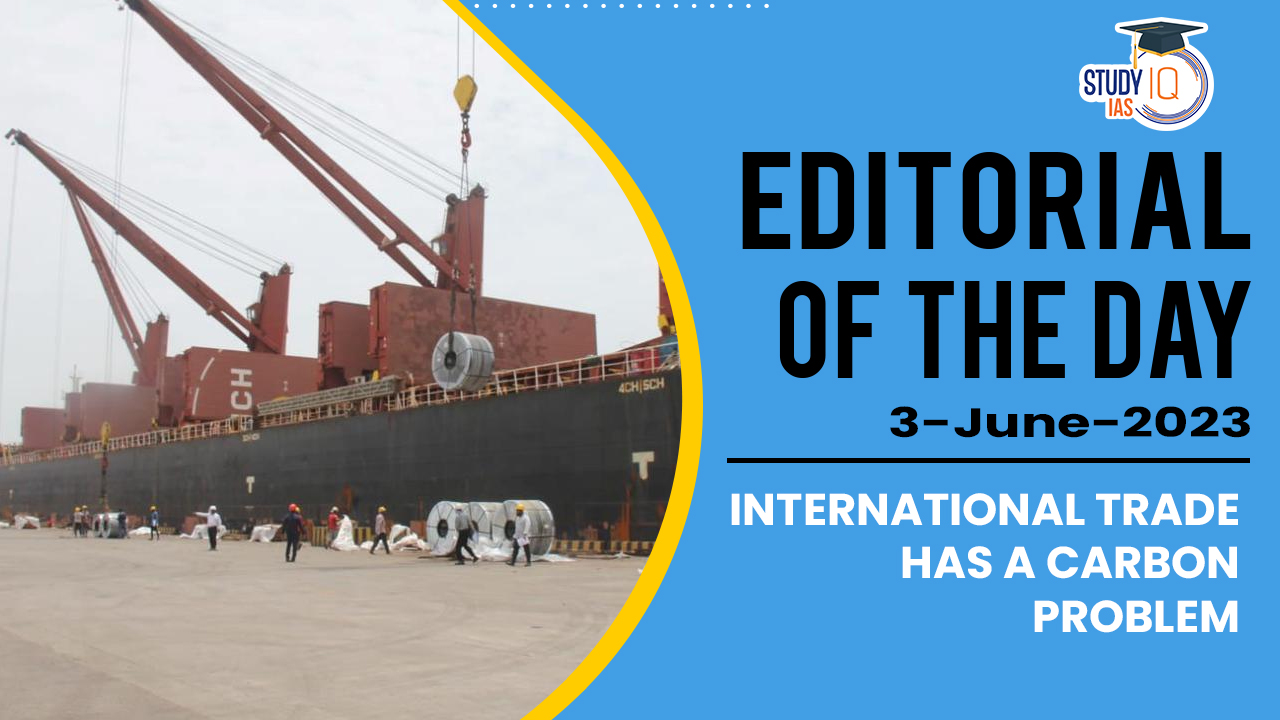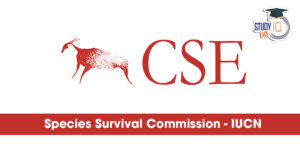Table of Contents
Context: The article discusses the European Union’s Carbon Border Adjustment Mechanism (CBAM) and its potential impact on India’s export of carbon-intensive products to the EU. It highlights India’s concerns about the CBAM being protectionist and discriminatory, leading to discussions of challenging it at the World Trade Organization (WTO). The article also addresses the inter-linkages between trade and the environment, emphasizing that environmental protection should not be used as a smokescreen for trade protectionism. It explores the WTO consistency of the CBAM and its potential violation of non-discrimination principles. Additionally, the article mentions the ongoing India-EU free trade agreement negotiations and the importance for India to engage with the EU on CBAM to secure gains for its exporters.
International Trade has a Carbon Problem Background
What is the European Union’s Carbon Border Adjustment Mechanism (CBAM)?
- It is a proposed policy that would place a price on the carbon content of certain imported goods.
- It’s a type of carbon pricing mechanism designed to prevent carbon leakage, which occurs when companies move their operations to countries with weaker climate policies to avoid carbon pricing or other climate regulations.
- Need for CBAM:
- In 2005, the EU has implemented the Emissions Trading System (ETS) to regulate greenhouse gas emissions within its borders.
- However, the EU fears that industries in other countries with less stringent emission regulations may have a competitive advantage over EU industries, leading to carbon leakage.
- To address this issue and level the playing field, the CBAM is proposed.
- It aims to ensure that imported goods from countries with lax carbon pricing policies bear similar economic costs as EU-produced goods covered by the ETS.
- CBAM was legislated as part of the European Green Deal, it takes effect in 2026, with reporting starting in 2023.
- The European Green Deal, approved in 2020, is a set of policy initiatives by the European Commission with the overarching aim of making the EU climate neutral in 2050.
About the EU Emissions Trading System (EU ETS)
- It is a carbon market based on a system of cap-and-trade of emission allowances for energy-intensive industries and the power generation sector.
- It is the EU’s main tool in addressing emissions reductions.
- Since its introduction in 2005, the EU’s emissions have decreased by 41%.
How will the CBAM work in practice?
- Companies that want to import goods produced outside the EU into the EU will have to purchase certificates corresponding to the amount of emissions generated in the production of those goods.
- The European Commission will calculate the price of CBAM certificates to reflect the average weekly price of ETS auctions.
- This means that CBAM certificates will be pegged to the ETS. This will ensure that the price of CBAM certificates is as close as possible to the price of ETS allowances while also ensuring that the system remains manageable for the administrative authorities.

Which sectors and emissions are covered by CBAM?
- Initially, CBAM will cover direct emissions (scope 1) of selected sectors: iron and steel, cement, aluminum, fertilizers and electricity.
- The greenhouse gas emissions regulated by the CBAM correspond to those emissions covered by Annex I to the EU ETS, namely carbon dioxide (CO2) as well as, where relevant, nitrous oxide (N2O) and perfluorocarbons (PFCs).
- Indirect emissions (scope 2) will not be covered in the initial phase but can be added after the transitional period.
Decoding the Editorial
The article begins with a discussion of India’s concerns about the EU’s CBAM
- India’s concerns about the EU’s CBAM?
- India is Europe’s third-largest trading partner, and it does not have its own carbon tax or cap. So, CABAM is a cause of concern for India.
- Important to note, countries in the EU combined represent about 14% of India’s export mix for all products, steel and aluminum included.
- Given India’s products have a higher carbon intensity than its European counterparts, the carbon tariffs imposed will be proportionally higher making Indian exports substantially uncompetitive.
- A UNCTAD study predicts that India will lose $ 1-1.7 billion in exports of energy-intensive products such as steel and aluminum.
- While India’s exports may be limited to aluminum, iron, and steel, and affect only 1.8% of its total exports to the EU, India has reportedly decried CBAM as being protectionist and discriminatory.
- There is also talk of challenging the CBAM at the World Trade Organization (WTO)’s dispute settlement body.
- Discriminatory nature of CBAM:
- A cornerstone principle of WTO law is non-discrimination. Thus, countries are required to accord equal treatment to ‘like’ products irrespective of their country of origin (most-favoured nation treatment) and to treat foreign-made ‘like’ products as they treat domestic ones (national treatment principle).
- While the CBAM’s design is origin-neutral in appearance, it may, in its application, discriminate between goods from different countries on account of an inadequate carbon pricing policy, or due to onerous reporting requirements that importers would be subject to.
- For example, the production processes for steel can vary, with some being less carbon-intensive than others. If products are not deemed “like,” the rules of non-discrimination would have limited application.
- Additionally, the CBAM’s discriminatory nature arises from its selective consideration of explicit carbon prices while disregarding implicit costs or non-price-based costs borne by products originating in certain countries.
- Justification for CBAM’s discrimination:
- Even if the EU’s CBAM is discriminatory, there could be a claim for justifying it under the General Exceptions clause given in Article XX of the General Agreement on Tariffs and Trade (GATT).
- The CBAM could fall under the policy ground of ‘conservation of exhaustible natural resources’ as it aims to address the issue of carbon leakage and promote environmental conservation.
- Way ahead for India:
- Finally, CBAM is also an important issue in the ongoing India-EU free trade agreement negotiations.
- India should work with the EU to secure gains on CBAM and ensure smooth onboarding for Indian exporters to maximize the benefits of a bilateral deal, even as the possibility of a WTO challenge remains open.
Beyond the Editorial
What are the other challenges associated with CBAM?
- Complexity: The CBAM is a complex policy proposal that involves assessing the carbon content of imported goods, issuing certificates, and ensuring compliance with reporting and payment requirements.
- Trade disputes: The CBAM is likely to face opposition from non-EU countries, who may view the policy as a form of protectionism.
- Complexity of calculating carbon content: It could be challenging to calculate the carbon content of certain products, especially if the production process involves multiple stages or takes place in countries with weaker climate policies.
- Double carbon pricing: There is a risk of double carbon pricing, where companies would be subject to carbon pricing both in the EU and in their home country. This could lead to increased costs for businesses and could undermine the effectiveness of the CBAM.
What are the other carbon pricing mechanisms available?



 UPPSC Answer Key 2025 Out : Check Offici...
UPPSC Answer Key 2025 Out : Check Offici...
 Light Weight Modular Missile (LMM) — I...
Light Weight Modular Missile (LMM) — I...
 Species Survival Commission (SSC) – IU...
Species Survival Commission (SSC) – IU...




















